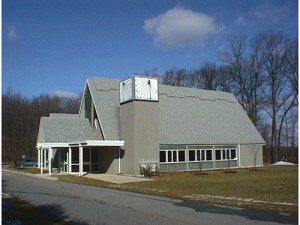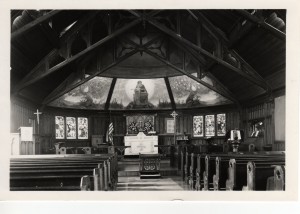This remarkable success story was, of course, a tangible example of God’s grace, not to mention the generosity and enthusiasm of the people in St Stephen’s pews. But it was also the result of the inspired work of a remarkable team of fundraisers.
Four men and a woman were primarily responsible for the heavy lifting on the initial stages of the fund drive: Edie Curran, Jim Peters, Bill Downey, Tom Cadwalader, and the redoubtable Mary Stuart Barnhart.
The thing that united them was a life-long devotion to the Episcopal Church, its time-hallowed teachings, and its traditional Anglican liturgy. But as a team, they were a study in contrasts.
Frank “Edie” Curran, Jr., who passed away in 2010, was a hard guy to miss. He stood 6ft 2ins and weighed 220 pounds—unchanged from his days as both offensive and defensive tackle on the University of North Carolina’s football squad. His prowess on the football field earned him the nickname “Bear.”
“Edie” to his family and closest friends, he had been a member of the vestries of both Trinity Church, Towson, and All Saints Church at Bayhead, NJ—his family’s summer home. He was a founder of St Stephen’s, and, naturally enough, a lay reader and member of the vestry.
Born in 1928 in Greensboro, NC, Edie won a football scholarship to the UNC, graduating with a B.S. in business studies in 1949. Laid back, low key, with a ready smile and loads of Southern charm, Edie was the consummate salesman. For most of his career he had been a top sales engineer for Hackney Brothers Body Company, makers of refrigerated truck bodies.
Philip James Peters, by contrast, was a stockbroker of the old school. He had a wonderfully wry sense of humor. Instead of asking after one’s health, Jim was inclined to say: “If you were a bond, how would you be trading? Above par … below … ?”
Born in 1928, Jim graduated from the Baltimore Polytechnic Institute in 1946. At the University of Maryland, College Park, he was a star of the lacrosse team and an active member of the Kappa Alpha fraternity.
In 1953, after military service, Jim joined the Black and Decker Company. In 1959, he moved to Connecticut to become a stockbroker, returning to Baltimore in 1968 as Vice President and manager of Legg Mason Wood Walker’s office in the city. Seven years later he joined Baltimore Kidder Peabody, moving to Paine Webber (now UBS) as vice president (investments) in 1993.
Jim had been a long time member of the Church of the Holy Comforter, Lutherville, where he served as lay reader, senior warden, junior warden, and treasurer. In the early ’80s he become a founding member of this parish, again serving as lay reader, vestryman, and Rector’s Warden. He passed away, aged 78, in 2006.
Bill Downey, who passed away 2001, was the parish’s senior warden when I first arrived and not a day passes that I don’t remember him with great fondness. He was a prince of a man—generous, kindly, patient, and unfailing courteous.
A Baltimore native and a graduate of Boys Latin, Bill was another life–long Episcopalian frustrated by the departure of the church from its traditional roots. In the early 1980s, he left the Church of St Michael & All Angels to be come a founder of St Stephen’s.
Behind Bill’s affable exterior lay a steely inner resolve that served the parish well on many notable occasions. This inner resolve, I suspect, was essential in a career that included serving as personal assistant to Baltimore’s legendary mayor Tommy D’Alesandro, ticket sales manager for the Colts, and owner of a home maintenance and repair company—not to mention an abiding devotion to the game of golf.
Indeed, it was Bill’s contention that it had been golf that established 8:00 AM Eucharist as a Sunday institution. I asked him if he thought it might be a tad sacrilegious to attend a service simply because it afforded a good tee time afterwards. “Oh no,” he replied, “It couldn’t be that! Golf reinforces your Christianity.”
At first, I thought he was joking, but then I saw the steely glint in his eye. The next Sunday, he handed me an article for the newsletter that eloquently amplified his contention. For all of his easy-going nature, Bill was a man who stuck to his guns. Once he set his heart on a project, he didn’t give up.
Thomas F. Cadwalder, Jr., a retired insurance executive, had served as vestryman for a number of Baltimore’s Episcopal Churches, before helping to found St Stephen’s. He was the parish’s grass root, a mine of vital information and useful advice.
Tom exemplified the Christian gentleman—generous to a fault, unfailingly kind, and a faithful friend. Born in 1912, he was a direct descendant of Arthur Middleton, a signer of the Declaration of Independence, and General John Cadwalader, a friend of George Washington and the commander of the Pennsylvania troops in the 1776 campaign.
He attended Calvert School, the Gilman Country School, and graduated from the University of Pennsylvania. Acclaimed as a player of soccer and lacrosse, he was also a keen horseman. In later life, his prowess at tennis earned him medals in tennis at the 1999 Senior Olympics, and he played year round until his 94th year.
Tom was called to active duty 1941 with the famous 29th Division. On D-Day, as an artillery captain, he was the liaison officer with the Second Battalion 115th Infantry on Omaha Beach, Normandy. He was wounded in action the next day while acting as forward artillery observer.
He was awarded the Bronze Star and the Purple Heart. Tom remained with the National Guard after the war and retired in 1958 as a colonel, having modestly declined to accept retirement promotion to the rank of brigadier. He passed away in September 2007.
A retired first grade teacher, Miss Mary Stuart Barnhart joined St Stephen’s soon after it was founded. However, judging by her formidable investigative abilities, education’s gain was definitely the police department’s loss.
Mary tracked down, and covered the cost of restoring, St Stephen’s magnificent altar, which, in the late 1890s, had been presented by her family to St Matthew’s Church, Sparrows Point, in memory of her aunt Mary A. Owings, who died tragically young, in 1891.St. Matthew’s was demolished by Bethlehem Steel to make way for millions of dollars in upgrades and improvements to the Sparrows Point shipbuilding and steel making facility. After its demolition, the memorial altar and stained glass windows were shipped off to other parishes.
In 1990, when planning was under way for construction of our new parish church, Mary launched a search for her family altar. She was told, in no uncertain terms, that she was on a fool’s errand. More than 30 years had passed since St Matthew’s demolition and nobody knew to which parish the altar had been presented.
But Mary was implacable. First she traced St Matthew’s stained glass windows to a church near Bel Air, Maryland. Its rector told her that a silver flagon her family had presented to St Matthew’s had been given to St John’s, Glyndon.
The Rector of St John’s returned the flagon to Mary, but there was no trace at of the altar at the church. Eventually, Mary tracked it down to the Rosewood Center for the severely developmentally disabled. There she discovered the altar in a vast warehouse. It was in deplorable shape—filthy, with splintered wood and stove in marquetry—apparently quite beyond repair.
This verdict, however, reckoned without the skill of the irascible Commander Donald Kirk, another of the parish’s founders. Don, a painstaking and highly talented woodworker, restored it to its present magnificent condition.
Starting in 1991, together with financial guru Fred Himes, the team hammered out a three-pronged strategy for raising the cash to start building:
First, the four men directly approached parishioners and friends of the parish to request a financial pledge in support the building fund.
Second, they offered them repayable construction notes at one or two percent over the current rate for Certificates of Deposit. This was the brainchild of Fred and Jim.
Third, Fred Himes and Mary instituted what probably became the most popular fundraiser of all: “The Financial Challenge.” They recruited teams of donors to offer to match, dollar for dollar, financial gifts up to a set amount, say $10,000 or $20,000.
Later a fourth fund raising element was added—auctions, cabaret dinners, and the Cookie Walk, of which more next week.
The parish responded to these efforts with enthusiasm and within two years of hard work sufficient money had come in to start the process of construction. The fundraising, however, continued unabated—in order to service the $850,000 mortgage. GPH✠




